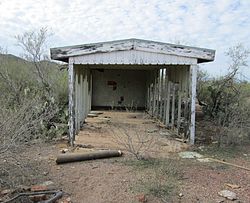Silver Bell, Arizona
| Silver Bell, Arizona | |
|---|---|
| Ghost town | |

A ruin in Silver Bell.
|
|
| Location in the state of Arizona. | |
| Coordinates: 32°23′05″N 111°29′56″W / 32.38472°N 111.49889°WCoordinates: 32°23′05″N 111°29′56″W / 32.38472°N 111.49889°W | |
| Country | United States |
| State | Arizona |
| County | Pima |
| Time zone | MST (no DST) (UTC-7) |
| Post Office opened | August 18, 1904 |
Silver Bell is a ghost town located in the Silver Bell Mountains in Pima County, Arizona. The name "Silver Bell" refers to a more recent ghost town, which was established in 1954 and abandoned in the 1970s. The original town, established in 1904, was named "Silverbell" and abandoned in the early 1930s. Both towns were utilized and later abandoned due to the mining of copper in the area.
According to James E. Sherman's Ghost Towns of Arizona, Silverbell was "one of the most renowned mining camps in the Southwest," and was also described as "the Hell-hole of Arizona." Today nothing remains of the town other than a cemetery.
The later Silver Bell was established when Asarco shifted their attention back to mining in the Silver Bell Mountains in the early 1950s. Located four miles southeast of the original town site, next to the present-day Silver Bell Mine, the town of Silver Bell was also short-lived, and only a few small ruins remain.
The history of mining in the Silver Bell Mountains is fairly convoluted, largely due to the dynamic nature of the copper business in the late nineteenth and early twentieth centuries. According to geologists and researchers, the richest, most densely exploited area occupied a narrow zone along the southwest flank of the range. Although copper was of primary interest, some silver, lead, and gold were also mined.
The first documented prospecting began in the early 1870s under the leadership of Charles O. Brown, who was from Tucson. By mid 1874, he and his partners had opened the Mammoth Lode, the Young America Mine, and a smelter. Other claims and mines established in the latter quarter of the century included the Atlas, Old Boot, and prospector mines; each was exploited by various short-lived partnerships, companies, and lessees. At this time in the American West, it was common for miners working in proximity to form self-governing "mining districts" in the absence of strong territorial authority. Miners elected a leader and a recorder, and they formed committees to establish district rules and boundaries. In time the term "mining district" developed a less formal, more geographical meaning. In the 1890s, two English companies entered the Silver Bell Mining District: the Silver Bell Mining and Smelting Company, Ltd., and the Tucson Mining and Smelting Company, Ltd. Both had very limited success.
...
Wikipedia


